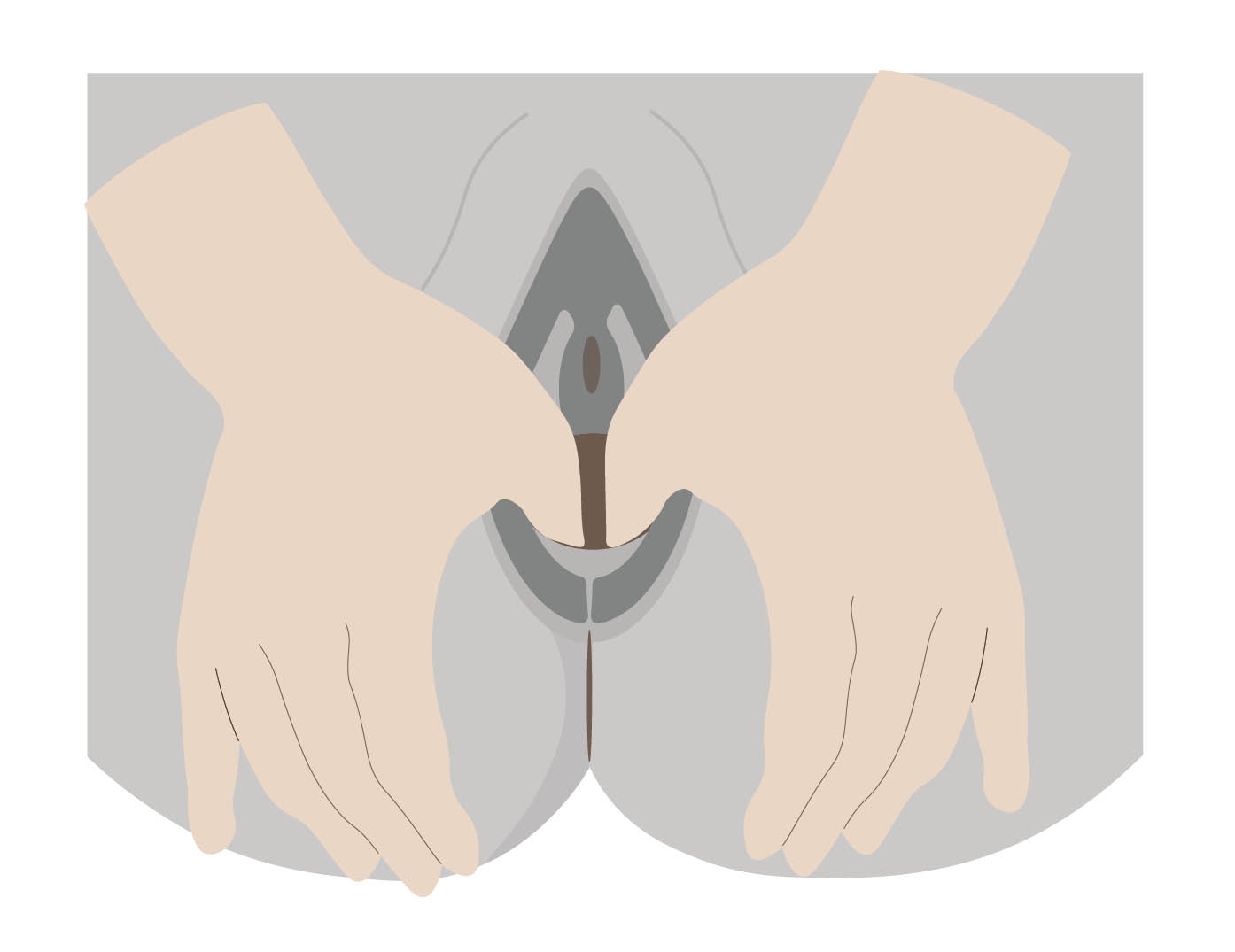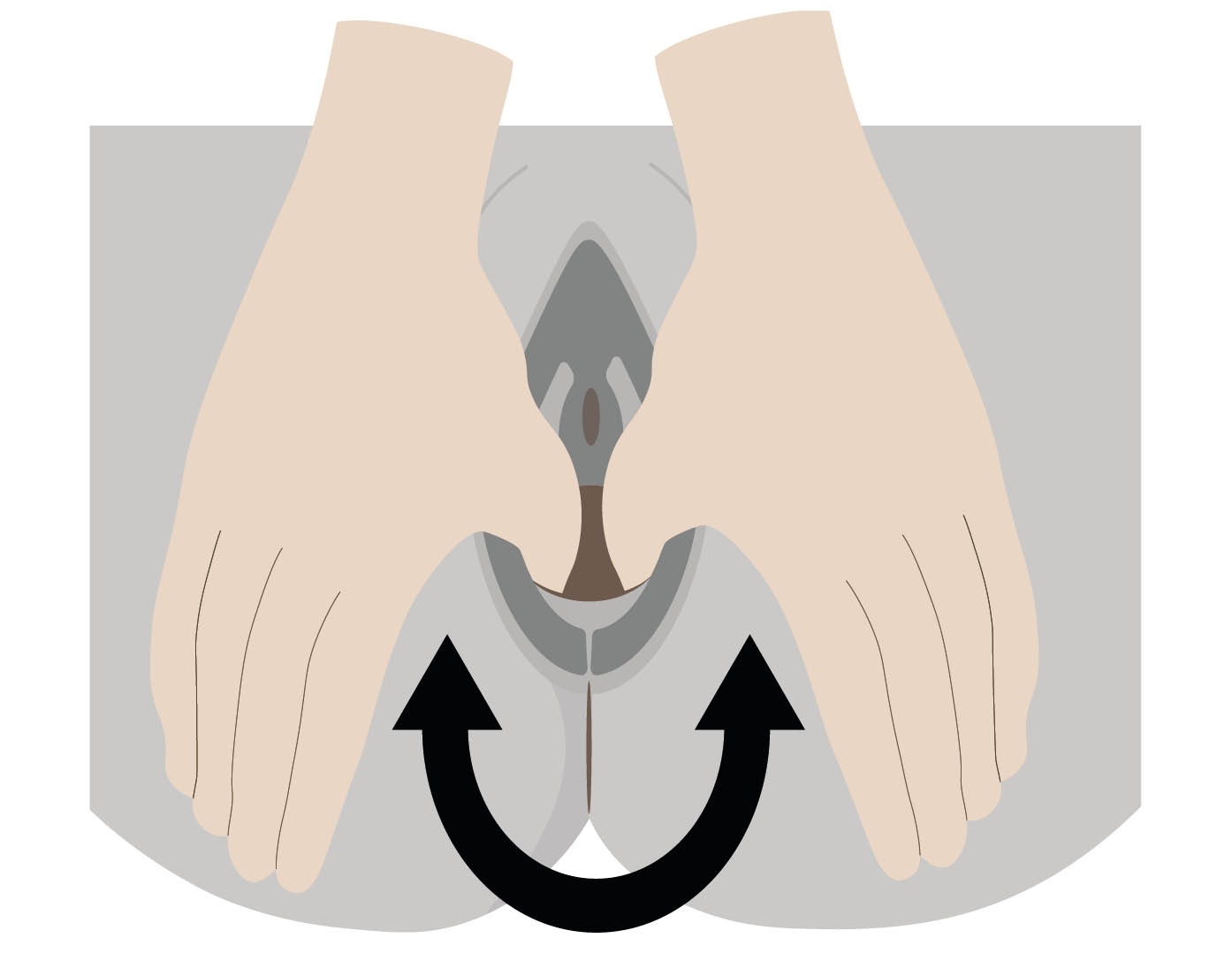Reducing the risk of perineal trauma during childbirth
A guide to antenatal perineal massage and the use of warm compress during labour
This leaflet provides you with information about what you and your healthcare providers can do to reduce your risk of perineal trauma during childbirth. If you have any questions after reading this leaflet, please speak to your midwife.
What is perineal trauma?
Perineal trauma is where you have either a tear or a surgical cut (episiotomy) to the perineum during childbirth. This is the area between your vagina and anus.
Why reduce the risk of perineal trauma during childbirth?
Tears can just happen during the delivery of your baby. They are caused by your baby’s head stretching your vagina and perineum.
Up to nine in 10 women who have a vaginal birth will have some kind of perineal trauma. This is slightly less common for a mother who has given birth vaginally before (Royal College of Obstetricians and Gynaecologists (RCOG), 2022).
For some women, the tear is likely to be small and will heal quickly. However, six or seven in every 10 women will need stitches to repair their tear. Others may have a more significant tear that needs repairing with surgery. This may lead to further complications such as faecal / urinary incontinence and pain during sex.
How can I reduce my risk of perineal trauma in pregnancy?
Perineal massage can help to prepare your perineum for childbirth. If done correctly, it will allow your perineum to stretch more easily. Research has shown that massaging your perineum from approximately 35 weeks of pregnancy, reduces your risk of perineal trauma and episiotomy, especially if you are having your first baby.
Perineal massage and warm compress may reduce the risk and / or the severity of injury. Please note, not every woman or pregnant person will be able to achieve this. Midwives and doctors use evidence-based techniques to protect the perineum as much as possible during childbirth.
Do I have to do it?
No, it is up to you to decide whether you do this, and some people do not feel comfortable doing it. If this is something you do not feel comfortable doing yourself, or you have difficulty reaching that area, you can ask your partner to support you in doing so. However, communication is very important. If you find it uncomfortable, your partner must listen to you and stop when you ask.
You may feel you do not want to do this at all. There are other things that your midwife can do to help reduce your risk of perineal trauma.
What happens if I can’t do it?
Some women will find it very difficult to reach their perineum in the late stages of pregnancy, or simply find it too uncomfortable.
Do not worry if you can’t do it. During the birth of your baby your midwife will discuss your options, and support you with other ways to help to protect your perineum.
How do I massage my perineum?
You can start perineal massage from around 35 weeks. Advice can vary about how often you should do this. For maximum benefit you should massage your perineum daily, or at least every other day.
It is important that you do not perform perineal massage if you have genital herpes, genital warts, thrush, or any other vaginal infections.
Be prepared
Wash your hands thoroughly. Make sure your fingernails are short, to prevent scratching yourself.
Find somewhere you can relax, uninterrupted and private.
Make sure you have your chosen oil and mirror handy if you need it.
Recommended oils: unscented organic oils (such as olive oil, grapeseed oil, or coconut oil). Or a water-based lubricant (such as K-Y Jelly). Do not use nut-based oils, Vaseline, or synthetic / mineral oils.
Find a comfortable position
Laying on the bed, propped up with pillows.
Reclining in the bath, with one leg at a time up on the side.
Standing in a warm shower, with one leg up on a stool before you change legs.
Sitting on the toilet.
Perform the massage
Lubricate your fingers / thumbs with your chosen oil / lubricant. Insert them 5cm into your vagina.
Press your thumbs / fingers down towards your anus. Then move your thumbs / fingers in an upwards and outwards movement (U-shaped movement).
Try to relax your pelvic floor muscles as much as possible, this will allow your perineum to stretch more. Your pelvic floor muscles are the muscles that are found between your tailbone (coccyx) and the pubic bone in your pelvis.
The massage can last as long as you wish, but try and aim for around three to five minutes.
-
 Insert your fingers / thumbs 5cm into your vagina
Insert your fingers / thumbs 5cm into your vagina -
 Press your thumbs / fingers down towards your anus
Press your thumbs / fingers down towards your anus -
 Then move your thumbs / fingers in an upwards and outwards movement (U-shaped movement)
Then move your thumbs / fingers in an upwards and outwards movement (U-shaped movement)
During birth, your perineum needs to stretch to allow your baby to be born. This can sometimes cause a burning feeling and be scary. By massaging your perineum, this can help you to become aware of what this may feel like. This awareness may help you to remain calm and in control when your baby is being born.
It is important that if you find perineal massage too painful then you must stop and speak to your midwife. They may be able to suggest a different technique for you.
What can my midwives do to help reduce my risk of perineal trauma?
Your midwife can offer to use a warm compress on your perineum when you are delivering your baby, or offer to manually support your perineum.
The use of warm compresses has been shown to reduce your risk of perineal trauma, and the need to have an episiotomy. An episiotomy is a cut made by your doctor or midwife through your vaginal wall and perineum, to make more space to deliver your baby.
Your midwife will gently place a swab / pad soaked in warm water against your perineum. This will be removed every few minutes, to make sure it stays warm and to check how well your perineum is stretching when your baby is being delivered.
There are no risks to using warm compresses. If you do not like the feeling of something warm on your perineum, you can ask your midwife to stop at any time.
Your midwife will also offer to manually support your perineum during the delivery of your baby. This involves the midwife placing their hand on your perineum and supporting it while it stretches. They will place their hand on your baby’s head to help slow the delivery. This will give your perineum time to stretch slowly.
This has been shown to reduce the risk of you having significant perineal trauma, which may need suturing in theatre (also known as a 3rd or 4th degree tear).
If you do not feel comfortable using warm compresses or having manual support from your midwife, please tell them. This is your choice, and you do not have to use either technique.
Further information
National Childbirth Trust (NCT) How to do perineal massage: a step-by-step guide
Royal College of Obstetricians and Gynaecologists (RCOG) Perineal tears and episiotomies in childbirth
What if I have any questions or concerns?
If after reading this leaflet you have further questions or concerns, please speak to your midwife.